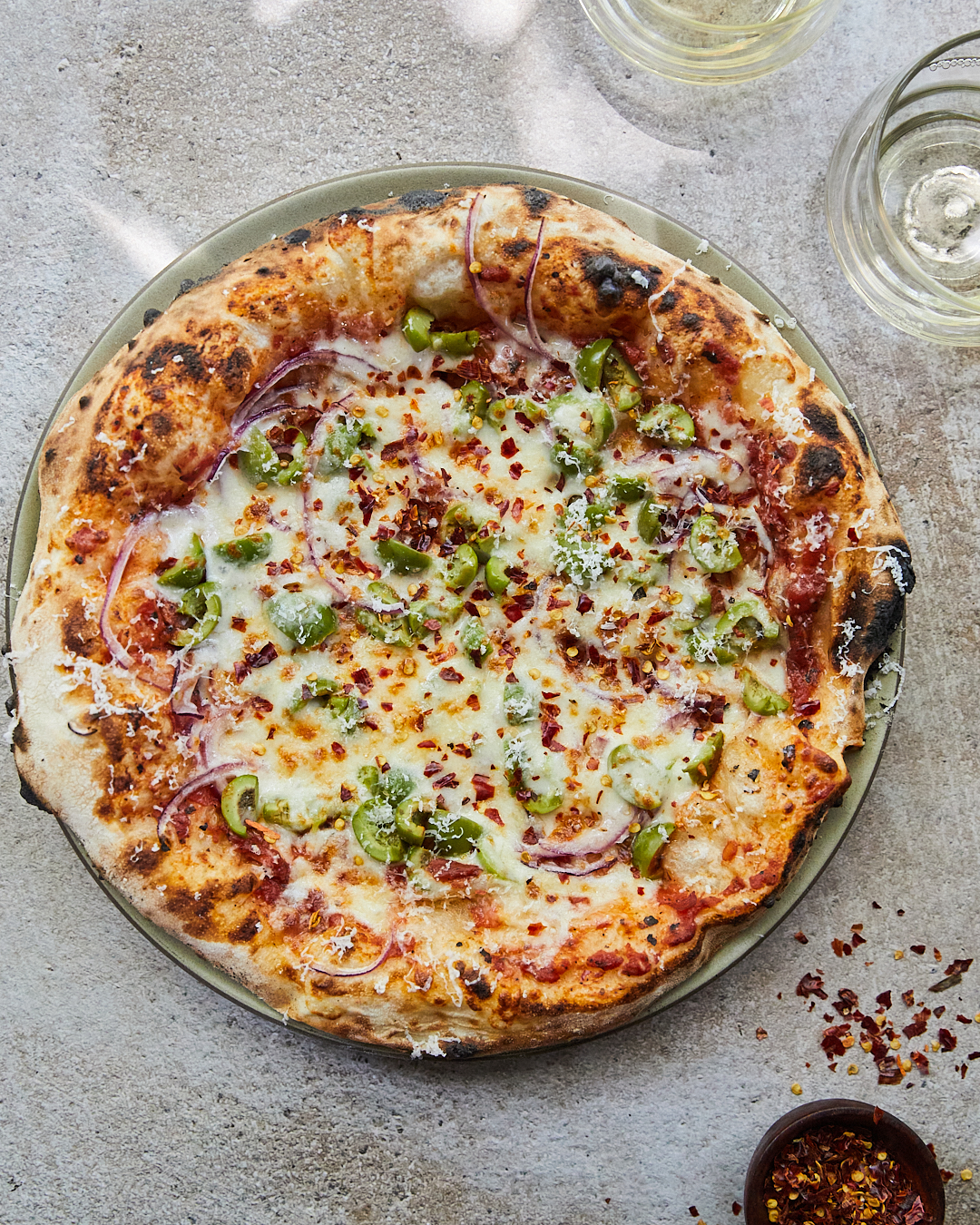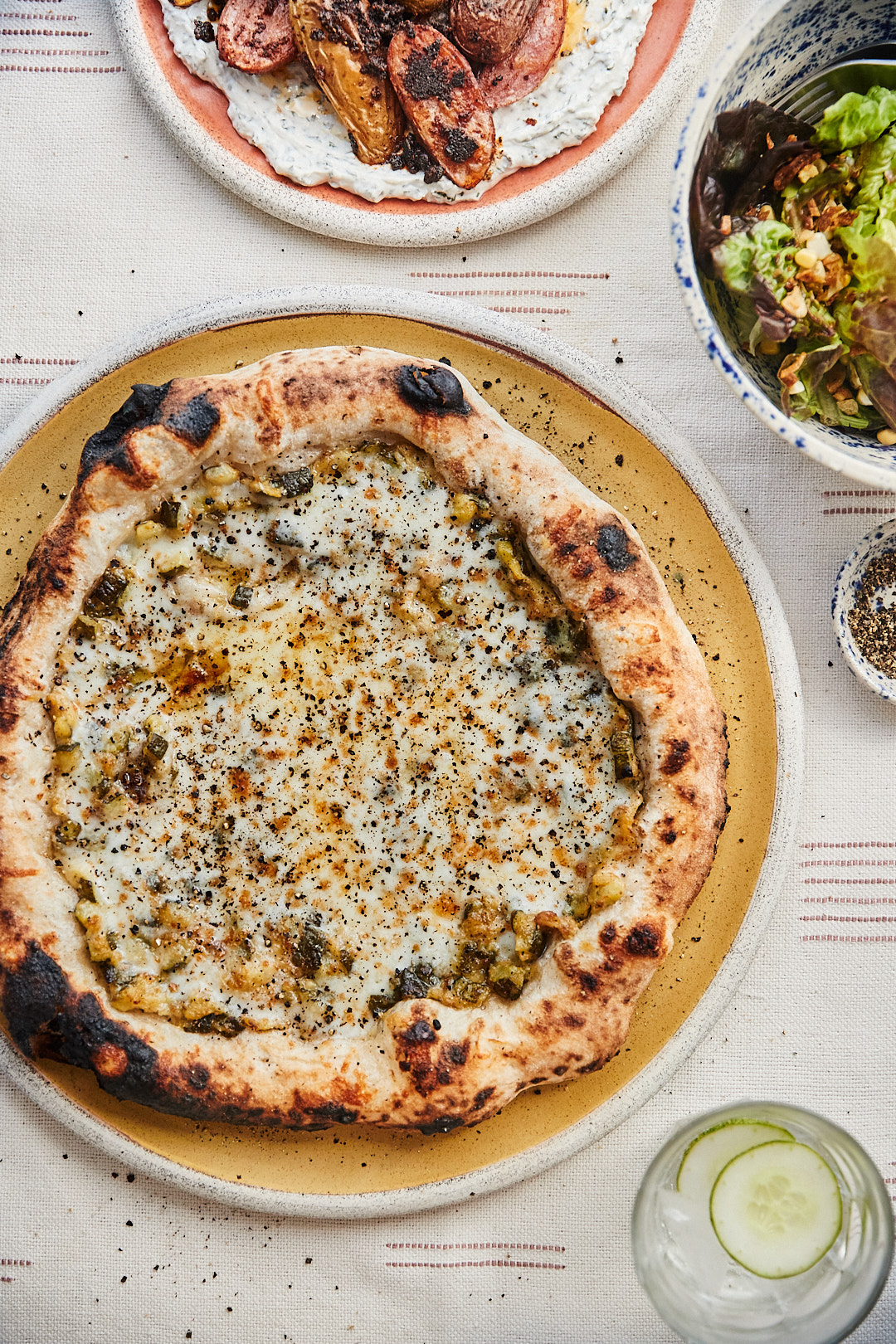
It is a publish that was initially created for Informal Zine.
Pizza has turn into a weekly custom in our home whereas being at house over the previous 12 months. It’s what I sit up for making every week. It’s additionally the factor I get essentially the most questions on, so I figured it was time to place a little bit of it to paper.
For starters, I’m not an professional. Every week I’m studying and taking part in round with completely different flours, dough hydration, pizza oven temperature, and toppings. However, issues end up fairly tasty, so beneath is a tough go at what I do with hyperlinks out for movies I discover useful (as a result of there’s a number of nuance to pizza dough, and once you get it, it’s unbelievable). This publish is simply the bottom pizza- I’ll do one other publish with topping concepts and issues I’ve accomplished.
For the dough base
I’ve been making a variation of the recipe for the same-day dough from the e-book Flour Water Salt Yeast by Ken Forkish. The recipe within the e-book says it yields 5 dough balls, however the place I’ve landed is chopping the recipe in half (500g flour) and yielding 3, 12” pizzas. I used to make the total recipe (1000g of flour) each different week and freeze half, however I discovered I similar to the texture of the contemporary dough higher. It’s value it to me to make the dough every week and is ideal for a household of 3-4 with a little bit of leftover pizza.
You too can discover fantastic sourdough recipes (I’d suggest this one) if that’s your jam. Ideally, it is going to be my jam one day- I’ve a tough time babysitting sourdough and remembering to feed it in time to make dough.
For the dough, I weigh out 500g of flour, 370g to 420g of 95˚F water, 10g of kosher salt, and 1g of prompt yeast. Ken’s recipe has a bit decrease hydration degree for the dough (350g), however I almost all the time use some portion of whole-grain flour.
My present ranges have been about 80% freshly milled wheat (normally mushy wheat like Chiddam Blanc or Wit Wolkoring) and 20% bread flour (both King Arthurs or Cairnspring). The mushy wheats don’t have the identical gluten power as a tough wheat, so the 20% bread flour is balancing that deficit. For this degree flour stability, I take advantage of 400g of water. If I do a portion of onerous wheat, I push the hydration degree nearer to the 420g degree. Wheat, particularly freshly milled, is a little more thirsty, and so the upper hydration retains the dough feeling mushy and workable. You could find the wheat flours I speak about at Grist + Toll or Capay Mill.
For mixing the dough
I comply with Ken’s methodology fairly carefully, and once more, would extremely suggest selecting up the e-book for detailed directions. Weigh the flour in a big container and weigh salt and yeast in separate small containers. Subsequent, weigh the water and pour about two tablespoons over the yeast, and stir. Pour the remaining water over the flour and mix along with your palms till many of the flour/water are included—cowl for 20 minutes.
After the flour has hydrated, make dimples on the highest and sprinkle the salt over. Stir the yeast and pour over the dough as effectively. Then, start stretching upwards and folding the sides of the dough over the salt/yeast combine. Then, use the pincer methodology (Ken has video explaining this course of a lot better than I might do in writing), repeating this course of till all the pieces is effectively included. End by shaping the dough right into a ball and canopy with a silicone cowl or plastic wrap.
Vital word: when stretching the dough, entire wheat doesn’t stretch close to so far as all-purpose or bread flour. The dough ought to by no means tear, so be a bit extra light with the entire wheat dough. And when you have no clue what I imply by stretch and fold, Ken explains it above, however right here’s one other useful publish/video as effectively.

For resting of the dough
After about 60 minutes, when the dough has unfold to fill the underside of the container, the dough will get another fold into a decent ball. Moist your palms and comply with the identical folding methodology for above. After this, the dough simply will get to sit back till double the amount. I normally search for air bubbles on the prime and a pleasant jiggle to the dough. Determining timing can take some experimenting to determine what’s finest.
As soon as the dough is prepared, tip the dough onto a floured floor and divide/form into three balls. This, too, has a course of, and I’d suggest watching this video (and once more, if utilizing entire wheat-heavy doughs, use a lighter contact).
As soon as your dough balls are formed, place them on a floured plate or tray, cowl them once more with silicone or plastic, and place them within the fridge. The dough can now chill within the fridge till you’re prepared to make use of it (as much as two days). Simply be sure you pull the dough from the fridge about 45 minutes earlier than cooking to heat the dough a bit.
For shaping the pizza dough
And eventually, shaping the dough as a result of this too is essential. There are a couple of completely different strategies for stretching the dough. The important takeaways for this are holding levity within the rim of crust and ensuring the underside of the pizza is skinny and even. I’m not a professional at this, so for this, I provide you with one other video (or I extremely suggest looking for New York Pizzaria movies on Youtube as a result of they’re enjoyable to observe).
I stretch the dough as I make every pizza. So stretch, prime, bake, repeat.
For cooking the pizza
I take advantage of my Ooni professional. Do you want a pizza oven to make nice pizza? In no way. Is it a hell of a number of enjoyable? Sure, sure it’s.
You too can use your oven and a forged iron pan. I warmth oil within the pan on the stovetop, slide the assembled pizza into the pan and cook dinner over medium (to medium-high) till the crust begins to puff and set. From there, I switch into an oven preheated to 450˚F and let it bake the remainder of the way in which. Resist the urge to drag the pizza early- the cheese must be bubbly, and the crust must be golden.
For reheating leftover pizza
Warmth a skillet with a lid and drizzle sufficient olive oil to cowl the underside of the pan. Warmth over medium-ish warmth, place slices within the pan and canopy with a lid. The crust will get a bit crisp, the cheese melts, and it’s a lot better than a microwave.

